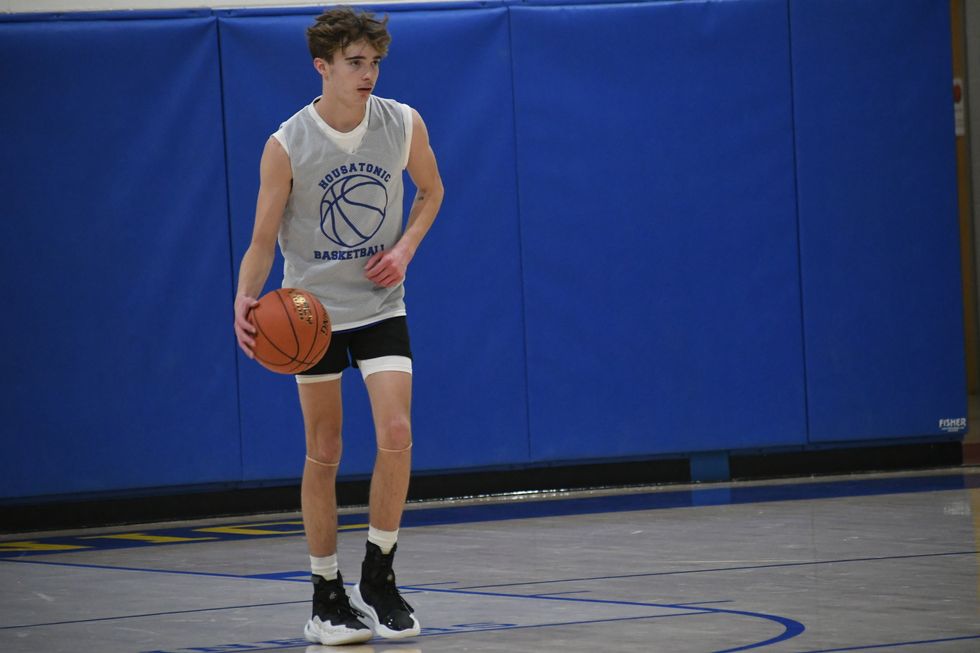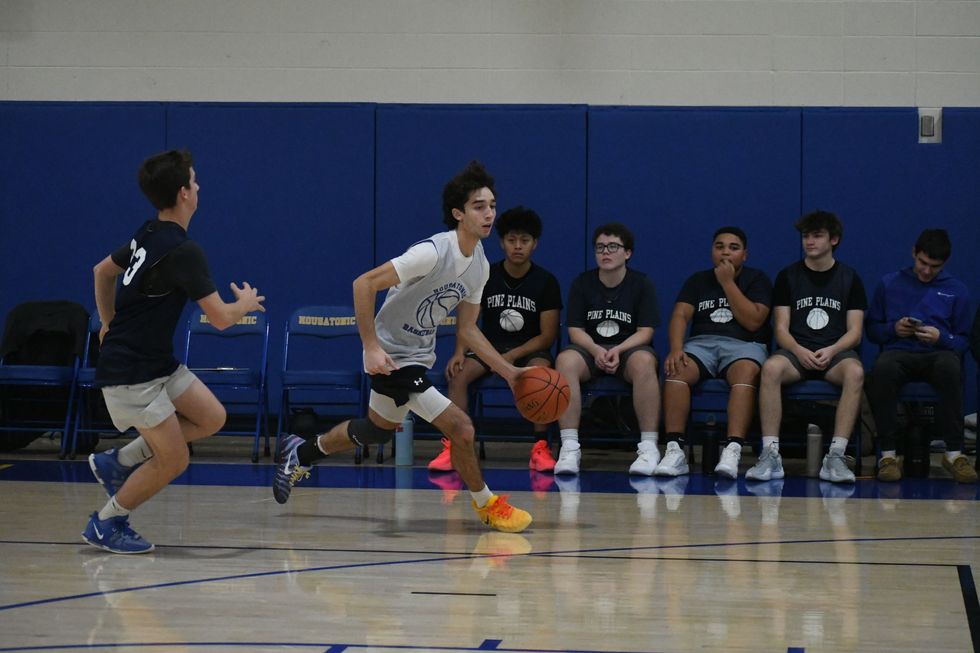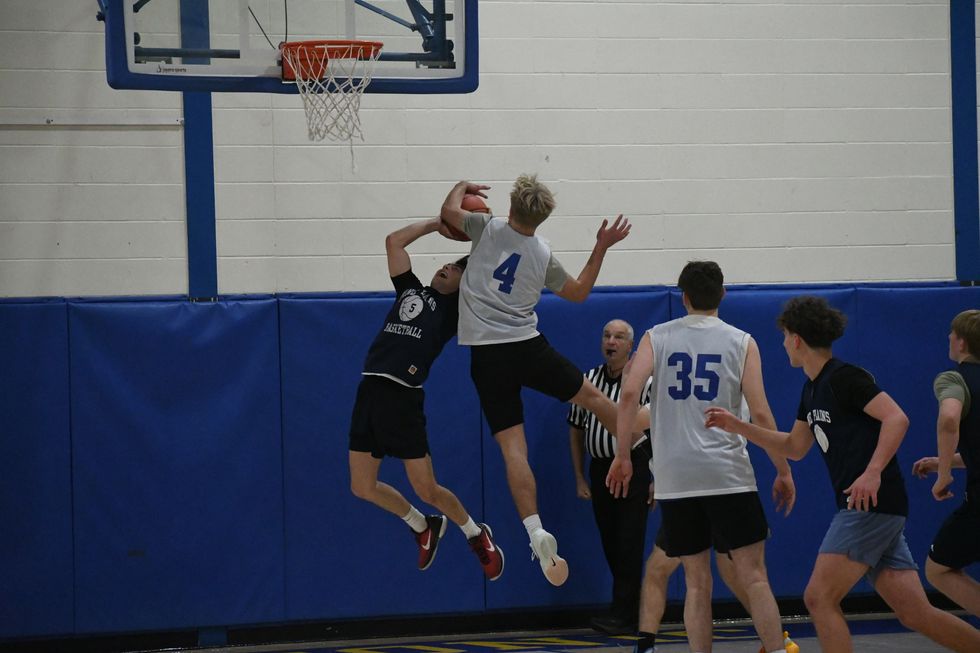Exploring indigenous origins along the Housatonic River

Susan Scherf addresses the group at the Institute for American Indian Studies’ exhibit demonstrating components of Algonkian semi-permanent village.
Alec Linden

Susan Scherf addresses the group at the Institute for American Indian Studies’ exhibit demonstrating components of Algonkian semi-permanent village.
WASHINGTON — The southern-most Housatonic Heritage Walk of the year brought the socio-ecologically curious to the steep ravines and river valleys of Washington, Conn., for a guided investigation of the region’s original occupants and ongoing stewards.
Hosted on the property of the Institute for American Indian Studies and the adjacent Steep Rock Preserve, Susan Scherf, an educator with the institute, led a leisurely and informative stroll amid pristine fall weather on Sept. 21.
Scherf, who has spent decades teaching students how to read and learn their natural landscapes, began the event with the important clarification that she herself is not Indigenous. “My maiden name was Van Winkle,” she joked.
She acknowledged that the land is the ancestral home of the Weantinock and Pootatuck people and their descendants, now the Schaghticoke. She spoke in awe of the complex technologies indigenous peoples developed through intimate knowledge of the landscape, such as tanning leather and sapping maples. These traditions, of course, were adopted by colonial communities and remain central components of New England culture today.
Scherf led the group of 14 participants down a hemlock-shaded slope into the Steep Rock Preserve proper, explaining that the Eastern Hemlock was almost entirely eliminated in New England by European colonists, who figured out that the tannin-laden bark was effective at curing animal hides. Native communities, on the other hand, used a process that involved curing skins with animal brains and smoking them to preserve and protect the material.
Pointing at a shagbark hickory, Scherf explained that “they never denuded the land,” using woody trees like ash, elm and oak to construct semi-permanent residences but never clear cutting as they moved from place to place. Other plants, like cattails which she described as “the grocery store” for its many uses, were also used to build structures like wigwams in these communities.
Guiding the group to an open area by a sluggish bend in the Shepaug River, a tributary of the Housatonic River, Scherf mentioned that “this would have been a main highway for Natives.” She explained that Connecticut’s rivers were vital infrastructure for these groups who would summer along the coast and winter in the interior. This river would have once been teeming with American Eels and salmon, she said, but Connecticut’s – the namesake of which is the Algonkian Quinnetukut, meaning the land alongside the long tidal river – waterways were also important to industrialists. As a result, the 4,000-odd extant dams have all but eliminated these fish in the state.
As the group crossed an old rail line, covered in century-old coal and slag, she noted that while the river valley was an infrastructural hub for industrialists, it once was a primary thoroughfare for these semi-nomadic Indigenous people who would travel the river on 30-foot, thousand-pound canoes made from the vast trunks of tulip trees.
She led the group back up the gentle wooded slope, pointing out various plants like jewelweed, which is a good balm for itchy ailments, and coltsfoot, which Natives would have burned and used as a spice. She encouraged participants to chew on wintergreen leaves she found alongside the trail, drawing murmurs of approval from the hikers for its fresh, minty taste.
To conclude, she gathered the group between a model longhouse and wigwam in the Institute’s demonstration village. She emphasized that while these communities lived in close mutual respect with the landscape, they also looked out for their fellow humans. “No one was ever excluded,” she said, “it was the whole village constantly working together.”
The Salisbury Winter Sports Association (SWSA) will host its annual Junior Jump Camp, a two-day introduction to ski jumping, on Saturday and Sunday, Dec. 27 and 28, from 9 a.m. to 2 p.m. at Satre Hill in Salisbury.
The camp is open to children ages 7 and up and focuses on teaching the basics of ski jumping, with an emphasis on safety, balance and control, using SWSA’s smallest hill. No prior experience is required.
The cost is $50 per child and includes instruction and lunch on both days. For more information or to register, visit www.skireg.com/swsa-camp or email info@jumpfest.org
Jesse Bunce, first selectman of North Canaan.
LITCHFIELD — The Northwest Hills Council of Governments welcomed six newly elected municipal leaders Thursday, Dec. 11, at its first meeting following the 2025 municipal elections.
The council — a regional planning body representing 21 towns in northwest Connecticut — coordinates transportation, emergency planning, housing, economic development and other shared municipal services.
Barkhamsted First Selectman Meaghan Cook, Goshen First Selectman Seth Breakell, Kent First Selectman Eric Epstein, Norfolk First Selectman Henry Tirrell, North Canaan First Selectman Jesse Bunce and Torrington Mayor Molly Spino were each elected to their post in November.
They filled the seats of their predecessors on the COG, who were each given a toast of appreciation: Nick Lukiwsky (Barkhamsted), Todd Carusillo (Goshen), Marty Lindenmeyer (Kent), Matt Riiska (Norfolk), Brian Ohler (North Canaan) and Elinor Carbone (Torrington).
COG Executive Director Rob Phillips said the outgoing members were given a going away mug that read “You’re living the dream still.” Members voted to appoint Warren First Selectman Greg LaCava to fill a vacancy on the Council’s Executive Committee. COG members voted by paper ballot, and LaCava defeated Burlington First Selectman Doug Thompson for the vacant seat.
Ryan Segalla takes a fadeaway shot over a defender.
FALLS VILLAGE — Housatonic Valley Regional High School’s boys basketball team defeated Pine Plains High School 60-22 in a scrimmage Tuesday, Dec. 9. The non-league preseason game gave both sides an opportunity to run the court ahead of the 2025-26 varsity season.
HVRHS’s senior-heavy roster played with power and poise. The boys pulled ahead early and kept their foot on the gas through to the end.
By halftime the score was 33-8. Junior varsity players subbed in for the second half, but not before the starters got some in-game dunk practice. By the end Housatonic totaled 60 points to Pine Plains’ 22.

Nick Crodelle led the Mountaineers offensively with 13 points. Anthony Labbadia and Wyatt Bayer scored nine points each. Anthony Foley scored eight points. Owen Riemer and Ryan Segalla each scored seven points. Peyton Bushnell hit a three-pointer. Jaxon Visockis and Henry Berry each scored two points.
HVRHS begins Berkshire League competition on the road at Nonnewaug High School Tuesday, Dec. 16, with a 6 p.m. tip off.


Katie Moore delivers toys to the Stuff a Truck campaign held by the Kent Volunteer Fire Department last weekend. Donated toys are collected so that parents, who need some assistance, may provide their children with gifts this Christmas. Accepting the donation are elves Fran Goodsell and Karen Iannucci
KENT — Santa’s elves were toasty warm as they collected toys for the children of Kent.
Keeping with annual tradition, Fran Goodsell and Karen Iannucci manned the Stuff a Truck campaign sponsored by the Kent Volunteer Fire Department on Saturday, Dec. 6, and Sunday, Dec. 7. Sitting in front of a fire pit in the firehouse parking lot between donations from residents, they spoke of the incredible generosity displayed every season. That spirit of giving was clear from the piles of toys heaped on a table.
“This is always so gratifying,” said Goodsell, noting that certain businesses, including High Watch Recovery Center, Wilson’s, and Kent and South Kent schools needed a “shout out” for all they’ve done. She said South Kent School focuses on gifts for older children, which is a group that often is overlooked.
Unwrapped contributions are sought for children 1 to 15 years old who might otherwise find little or nothing from Santa, they said. The bounty will be set up at the Community House on Thursday, allowing parents to come and take what they want. If there are still items left, grandparents are invited to “shop.”
The atmosphere was festive Saturday, as a stuffed dog began barking a Christmas tune whenever someone walked in front of it. A large decked-out bear posted at the parking lot entrance reminded passersby of the event. Visiting children were able to get a close-up look at the fire truck and walk through the firehouse if they wished.
Goodsell and Iannucci were very grateful to those who donated wood for the fire pit. “And so many asked if they could bring us coffee or hot chocolate,” said Iannucci.
Goodsell said many who came talked about having grown children who were recipients of the gifts when their families were struggling. “They are so glad to be able to give back,” she said.